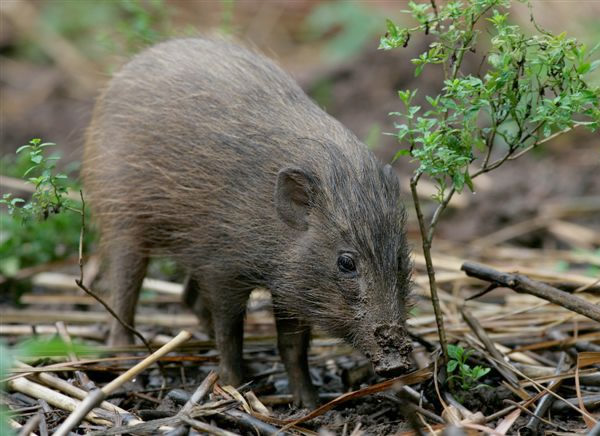 |
| Pygmy Hog |
Description and biology
The pygmy hog is the smallest of all pig species. An average adult pygmy hog is 25 inches (63.5 centimeters) long, stands 10 inches (25 centimeters) tall at its shoulder, and weighs 19 pounds (8.6 kilograms).
Its short tail measures only 1 inch (2.5 centimeters). Its hide is covered with coarse dark brown or black bristles. Because of its small, bullet–like shape, the animal is extremely agile.
Male pygmy hogs are larger than their female counterparts and have exposed tusks. The normally solitary males interact with the females only during mating season. A female pygmy hog gives birth to a litter of two to six infants, usually in late April or May, after a gestation (pregnancy) period of about 100 days. Both males and females build and use their nests throughout the year.
  |
Habitat and current distribution
Pygmy hogs inhabit dense, tall grasslands. They are found primarily in two wildlife sanctuaries in northwestern Assam (a state in far eastern India): Manas Wildlife Sanctuary and Barnadi Wildlife Sanctuary. Scientists estimate the total number of pygmy hogs to be no more than 300. The actual number may be far less.
History and conservation measures
The pygmy hog is one of the most endangered mammals in the world. Destruction of the animal’s habitat is the main reason. Farmers routinely set fire to grassland forests to clear them for agricultural use. Many pygmy hogs are killed because they cannot escape the extensive fires.
Those that do escape are forced onto very small grassland areas where they are sometimes killed by unexpected fires or onto tea plantations where they are often killed by hunters.
The international wildlife community and the Indian government have focused much attention on the pygmy hog’s plight. In 1985, the International Union for Conservation of Nature and Natural Resources (IUCN) placed the pygmy hog on its first list of the 12 most threatened species in the world.
The Indian government has given the animal the maximum legal protection allowed under its Indian Wild Life Protection Act. In 1986, the United Nations Educational, Scientific, and Cultural Organization (UNESCO) designated the Manas Wild-life Sanctuary as a World Heritage Site.
All these measures have done little to stop the destruction of pygmy hog habitat. If grassland fires in their habitat are allowed to continue unchecked, pygmy hogs will face extinction.
